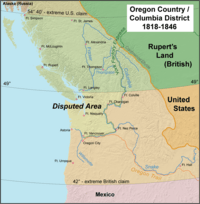Oregon Treaty facts for kids
| Treaty between Her Majesty and the United States of America, for the Settlement of the Oregon Boundary | |
|---|---|

Map of the lands in dispute
|
|
| Type | Bilateral treaty |
| Signed | 15 June 1846 |
| Location | Washington, D.C., United States |
| Original signatories |
|
| Language | English |
The Oregon Treaty was an important agreement signed on June 15, 1846. It was made between the United Kingdom (Great Britain) and the United States. This treaty helped solve a big disagreement over who owned the Oregon Country.
For many years, both Britain and the U.S. had claimed this land. They had been sharing it since the Treaty of 1818. The Oregon Treaty finally drew a clear border, ending the arguments.
Contents
What Led to the Treaty?
The Treaty of 1818 had set a border between the U.S. and British North America (which is now Canada). This border followed the 49th parallel north (a line of latitude) from Minnesota to the Rocky Mountains.
However, the land west of the Rocky Mountains was still shared. Americans called it the Oregon Country. The British called it the Columbia District. Both countries could claim land there and use its rivers freely.
Over time, sharing this land became difficult for both sides. The U.S. wanted to expand its territory. Some Americans wanted the border to go all the way north to 54°40′. This was the southern edge of Russian America (now Alaska).
But then, the Mexican–American War started in April 1846. The U.S. government, led by President James K. Polk, decided it was better to compromise. They wanted to avoid fighting two wars at once. So, they worked with Britain to find a peaceful solution.
The Senate's Decision in 1846
In June 1846, the British offered to talk about the border. Some U.S. senators, like Charles Gordon Atherton, wanted to refuse this offer. They wanted the U.S. to claim all the land.
But other senators, including Daniel Webster, thought it was better to negotiate. They believed a peaceful agreement was the best path forward. The British watched closely, hoping the U.S. Senate would agree to talk.
On June 12, the Senate voted. A large majority, 38 to 12, voted to recommend that President Polk accept the British offer. This vote showed that many U.S. leaders wanted to find a peaceful solution.
How the Treaty Was Agreed Upon
The treaty was negotiated by James Buchanan, who was the U.S. Secretary of State. For Britain, Richard Pakenham was the envoy (a special representative). George Hamilton-Gordon, 4th Earl of Aberdeen, the British Foreign Secretary, was also very important in making it happen.
The treaty was signed on June 15, 1846. It officially ended the shared control of the Oregon Country. People living south of the new border became American citizens. Those living north of it became British subjects.
The Oregon Treaty set the border at the 49th parallel north. However, there was one important exception: Vancouver Island. This island was kept entirely by the British. In 1849, Vancouver Island became a British colony.
The U.S. part of the region became the Oregon Territory in 1848. Later, the Washington Territory was formed from it in 1853. The British part remained unorganized for a while. But in 1858, the Colony of British Columbia was created. This happened because of the Fraser Canyon Gold Rush and British concerns about American expansion.
When British Columbia joined Canada in 1871, the border set by the Oregon Treaty became part of the Canada–United States border.
Key Parts of the Treaty
The treaty clearly stated where the new border would be. It said the border in the Strait of Juan de Fuca would follow "the middle of the channel." This channel separates the mainland from Vancouver Island.
However, this part of the treaty was a bit unclear. There were several possible channels. This led to a disagreement over who owned the San Juan Islands. This dispute caused the Pig War (1859) in 1859.
Other important parts of the treaty included:
- Ships from both countries could freely use the channels and straits south of the 49th parallel.
- The "Puget's Sound Agricultural Company" (a British company) could keep its property north of the Columbia River. If the U.S. needed this land, the company would be paid for it.
- The property rights of the Hudson's Bay Company and all other British people south of the new border would be respected.
Problems That Came Up
The unclear wording about the border in the Strait of Juan de Fuca caused the Pig War (1859). This was a disagreement over the San Juan Islands. It was called the "Pig War" because it started when an American farmer shot a British pig!
This dispute lasted for about a decade. But it was solved peacefully in 1872. Both sides agreed to let a neutral person decide. This person was Wilhelm I of Germany, the German Emperor. He decided that the islands belonged to the United States.
Another unexpected result of the treaty was Point Roberts, Washington. This small piece of land is a peninsula that sticks south from Canada. Because it is south of the 49th parallel, it became a part of the United States, even though it's surrounded by Canada on three sides.
The treaty was generally well-received. Many people in Britain were happy with the agreement. It helped avoid another war and brought stability to the region.
See also
 In Spanish: Tratado de Oregón para niños
In Spanish: Tratado de Oregón para niños

